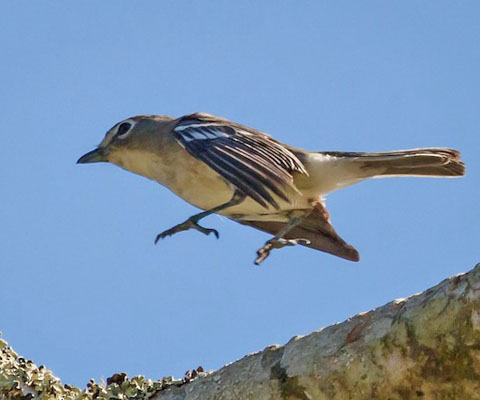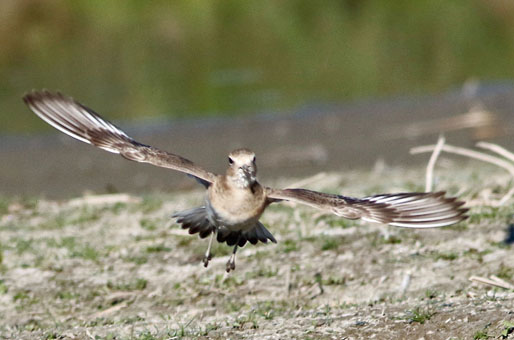These highlights chronicle the year 2020. The year runs generally
"backwards" on this page. In crediting records of vagrant or unusual birds, I always try to credit the finder(s) of the rarity. There will be times when complications arise with credit, e.g., one or more observers find a bird but others are the ones to actually identify it. There are times when a bird is properly identified only days later after photo review.
The abbreviation "MTY" means "Monterey County"
in the text below. Text by Don Roberson. Photos on this page
are copyrighted by the photographers to whom they are
attributed, and may not be reproduced in any form (including
other web sites) without the express consent of the photographer. |
| |
 The most exceptional bird for December appeared in a backyard at the Lobos Ranch development on 21 Dec: an immature Painted Bunting (right; photo © John Hiles). Unfortunately it did not linger, and was never seen again. This is the 16th MTY record, almost all of which have been hatch-year birds in fall, but this Dec vagrant was quite late. Five of the prior records were from residential back yards. The most exceptional bird for December appeared in a backyard at the Lobos Ranch development on 21 Dec: an immature Painted Bunting (right; photo © John Hiles). Unfortunately it did not linger, and was never seen again. This is the 16th MTY record, almost all of which have been hatch-year birds in fall, but this Dec vagrant was quite late. Five of the prior records were from residential back yards.
Another December highlight was the presence of at least five different Yellow-bellied Sapsuckers: two from 4-13 Dec in Caledonia Park, P. G. (Gary Dial, Paul Fenwick; photos appear to show 2 different juvs, so not a continuing bird from last year); juv male at Lagunita Mirada, Monterey, from 19 Dec into 2021 (Amanda Preece, Carole & Larry Rose +); juv female in Carmel 17-24 Dec (Joan Tisdale); and a juv male along Old Coast Road 20 Dec (Eliana Heiser, Amanda Preece). |
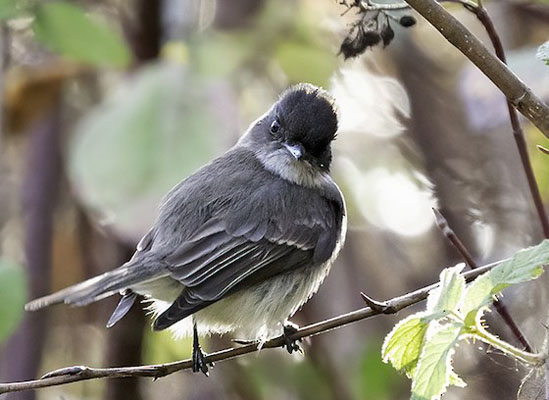 The best bird found on the Monterey Peninsula CBC on 28 Dec was an Eastern Phoebe along the Carmel River, just upstream from the Highway 1 bridge, discovered by Bill Hill (photo right, © Bill Hill). Also on the count was a Tropical Kingbird, probably returning for a second winter, at Laguna Grande, which appears to have arrived about 30 Oct. At Locke-Paddon Park in Marina a Northern Waterthrush is wintering; it also apparently arrived on 30 Oct. Meanwhile, a young Costa's Hummingbird at a yard in Carmel Valley Village, which first arrived 5 Aug, is wintering (B.L. Sullivan; an extensive series of photos in eBird document its body molt throughout fall and into winter). The best bird found on the Monterey Peninsula CBC on 28 Dec was an Eastern Phoebe along the Carmel River, just upstream from the Highway 1 bridge, discovered by Bill Hill (photo right, © Bill Hill). Also on the count was a Tropical Kingbird, probably returning for a second winter, at Laguna Grande, which appears to have arrived about 30 Oct. At Locke-Paddon Park in Marina a Northern Waterthrush is wintering; it also apparently arrived on 30 Oct. Meanwhile, a young Costa's Hummingbird at a yard in Carmel Valley Village, which first arrived 5 Aug, is wintering (B.L. Sullivan; an extensive series of photos in eBird document its body molt throughout fall and into winter).
On 6 Dec, the male Summer Tanager in Pacific Grove (named "Verano" by Rita several years ago), returned for its 8th consecutive winter! Published life span is "at least 5 years" from banding data; might we have a record-breaker here? It is wintering again (still here as I write in Feb 2021) and frequenting its old, regular spots over a route that extends from the Pacific Grove ballpark to Asilomar (B. Matheson, R. Carratello, D. Roberson). A second Summer Tanager, either a female or first-year male, frequented ornamentals on Cass St., Monterey, from 14-28 Dec (Steve Rovell).
|
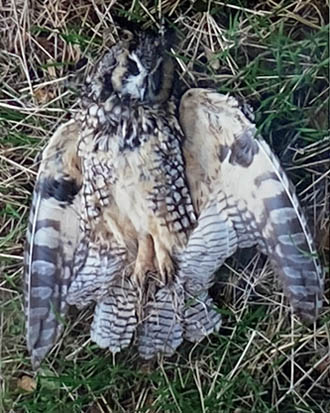 |
Long-eared Owls have long been enigmatic in MTY. Recent surveys by eBirders suggest a good population in southeastern MTY; there are scattered winter roosts from south county; and there a few owls at the north end of the Santa Lucia Mts. Yet records for the Monterey Peninsula or Moss Landing are rare. We had two records in December.
- A freshly-killed Long-eared Owl was found on Elkhorn Slough National Estuarine Research Reserve on 5 Dec (left). It is now frozen for a museum specimen (photo courtesy of ESNERR via Tricia Wilson & Dave Feliz; and
- a happily alive Long-eared Owl roosted for a single day (24 Dec) in a Pacific Grove backyard (right; photo © Kim Akeman)
The latter reminded long-time locals of a similar one-day-wonder roost in the P. G. backyard of Brian Weed & Jan Scott back on 19 Nov 1996. |
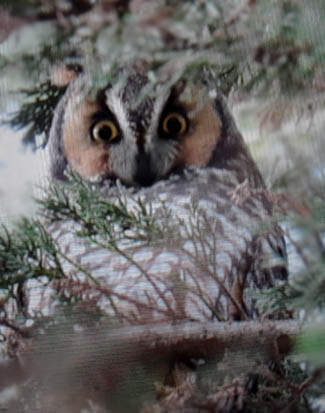 |
|
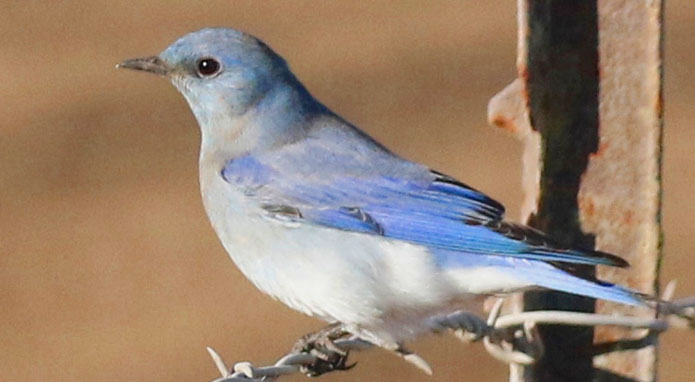 Mountain Bluebird is a regular winter visitor to barren grasslands in the southeast corner of MTY, in varying numbers year-to-year. The species is otherwise quite rare around the Central Coast, and there are only about 8 records on or near the immediate coast of MTY in the last 50 years. Mountain Bluebird is a regular winter visitor to barren grasslands in the southeast corner of MTY, in varying numbers year-to-year. The species is otherwise quite rare around the Central Coast, and there are only about 8 records on or near the immediate coast of MTY in the last 50 years.
Thus a gorgeous male Mountain Bluebird at Moonglow Dairy, found by Paul Fenwick on 1 Dec, was a surprise (right, photo 1 Dec © D. Roberson). It lingered to at least 5 Dec. |
 We understand that many migrant passerines in fall migration undertake flights at night, and if they are misoriented they may find themselves out over the ocean at dawn. It is believed, based on studies on the Farallon Islands, that such migrants "backtrack" to the nearest land to rest and forage before continuing their migration. In theory, then, a migrant passerine could occur almost anywhere along our coastline. Kathleen Keef, a visitor from Reno, encountered two very unexpected fall vagrants in coastal beach scrub in early December. One was this Green-tailed Towhee on the driftwood-littered sand at Big Sur R. mouth, found on 2 Dec and still present a week later (right, photo from 9 Dec © Karen Kreiger). This was the 3rd MTY Green-tailed Towhee for fall migration 2020. The others were at Martin Canyon, off lower Carmel Valley, 4-5 Oct (Michael Rieser) and another upstream of the Big Sur R. mouth on 5 Oct (Aaron Gabbe). We understand that many migrant passerines in fall migration undertake flights at night, and if they are misoriented they may find themselves out over the ocean at dawn. It is believed, based on studies on the Farallon Islands, that such migrants "backtrack" to the nearest land to rest and forage before continuing their migration. In theory, then, a migrant passerine could occur almost anywhere along our coastline. Kathleen Keef, a visitor from Reno, encountered two very unexpected fall vagrants in coastal beach scrub in early December. One was this Green-tailed Towhee on the driftwood-littered sand at Big Sur R. mouth, found on 2 Dec and still present a week later (right, photo from 9 Dec © Karen Kreiger). This was the 3rd MTY Green-tailed Towhee for fall migration 2020. The others were at Martin Canyon, off lower Carmel Valley, 4-5 Oct (Michael Rieser) and another upstream of the Big Sur R. mouth on 5 Oct (Aaron Gabbe).
Even more unexpected was a hatch-year Blackburnian Warbler that Kathleen Keef photographed in coastal scrub at Garrapata SB on 1 Dec (below, both photos © K. Keef, left-hand photo with Townsend's Warbler). The shot of the Blackburnian standing on sand is just superb. December Blackburnians are quite rare, and only one has wintered locally: 29 Dec 1986-22 Mar 1987; found by D. Roberson in Pacific Grove).
There were 5 other Blackburnians found in fall 2020: two at El Estero, Monterey, 23 Sep (B.L. Sullivan, P. Fenwick), and singles near Yankee Pt. 13-16 Sep (L. Stephenson), Laguna Grande 25-28 Sep (M. Kudrav), and the P.G. cemetery 1 Nov (B.T. Matheson). |
|
| Traditionally we consider August through November to be "fall migration," with August pretty much devoted to shorebird (and seabird) migrants, and just September through November as the window for vagrant passerines. As we've seen just above, though, sometimes migrant passerines are still on the move in December. North American Birds magazine — to which every serious birder should subscribe — publishes continent-wide seasonal summaries of birds and bird patterns of interest (the magazine also publishes important i.d. papers). I've been the Monterey County compiler for NAB for 40 years. Writing up MTY records of interest for each "fall migration" issue takes hours of volunteer work every year. This year was a particularly good fall migration locally — and that's about the only good thing we can say about Covid-19 dominated 2020. The accounts for NAB are meant to be a complete compilation of seasonal rarities. But these pages, here on my website, are meant to be brief summaries. I emphasize here birds that have photos. I've make no attempt to mention the more-regular vagrants we encounter each autumn migration (absent someone's amazing photo). With that caveat, here are some birds that impressed me in fall 2020. As always, these "read" backwards in time as one scrolls down the page. |
|
|
Locke-Paddon Park in Marina had a strong year, going back to the Gray Catbird discovered there by Kent Van Vuren in July, and which lingered to 20 Sep (see prior seasonal report). On 13 Nov, Kent Van Vuren found another great bird at Locke-Paddon: this hatch-year Canada Warbler (above left, photo 13 Nov © Carole Rose). It was both a first for that park, and the only one this year. Also in mid-November, up to 3 Cassin's Finch appeared in Paul Fenwick's yard overlooking Carmel Valley Village (one shown above right, photo 13 Nov © P. Fenwick). Given the influx of a half-dozen to Mt. San Benito, the next county east of us, we had been expecting some to occur here, but the flight seemed to have fizzled. The last significant flight that reached MTY was in October 1996, when 5 were at Jacks Peak, and few others were scattered elsewhere, including to the Big Sur coast.
On the final day of October, Amanda Preece found a male Vermilion Flycatcher on the golf course at Pt. Pinos — it was viewed off-and-on that day at a distance, and then was gone. The distant photos compare nicely with photos of the first-year male Vermilion Flycatcher at this same location on 25-26 Oct 2019, found by Mark Kudrav and discussed in that seasonal report, but with more red in the upperparts. It is believed that this year's 31 Oct Vermilion was a brief return of last October's flycatcher, which also did not linger long on its autumnal flight.
Here's two stories about big birds. On 28 Oct, Paul Fenwick saw a Tundra Swan on Odello Lagoon — most of which can be seen from "Cross Hill" at Carmel River SB — but the swan swam swiftly to a remote spot farther east and out of view. Some observers saw it roosting at this difficult-to-see location, where it seemed to be sleeping a lot. On 2 November, Amanda Preece and two friends went paddle-boarding up Odello Lagoon and discovered the now-deceased swan (below left; that's Amanda with the swan, photo © Jan Loomis). Amanda, who had previously worked wildlife rehab, reported that she "checked it over and it had no external injuries but was emaciated." We see very few wild swans in MTY; sadly, this one did not survive its visit.
Near month's end (25 Nov), Colin Meusel and Robert Horn both happened to be sea-watching at Pt. Pinos. As you can see in Colin's photo of the scene (below right), a boat was passing the Point; there's a cormorant in flight closer to us (just below the 2 folks on the bow), and the is a big white-bodied bird flying east, and just left of the rock seen in the lower right-hand corner of the photo (© Colin Meusel). Colin got out his video camera while Robert viewed with his scope. The big bird proved to be an apparent adult Masked or Nazca Booby, and the impression of both observers was that the bill was a bit orange. While nothing in the video-grabs appears definitive, it seems quite likely this was an adult Nazca Booby — a species that has recently occurred in such numbers in southern California that was just removed from the California Bird Records Committee (CBRC) list of species they review. |
|
|
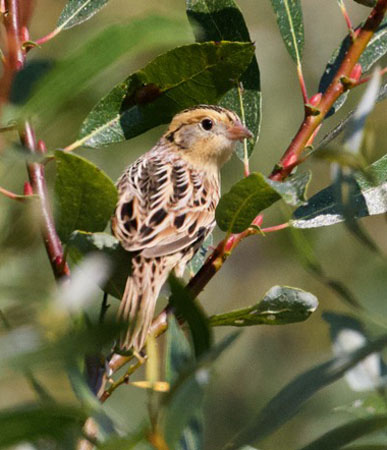 October also brought the first "chasable" Mourning Warbler for quite some years. Mark Kudrav discovered this hatch-year female frequenting the edge of run-off puddles in Hatton Canyon on 3 Oct; it remained through 5 Oct (above left, photo 5 Oct © Bill Hill). It was mainly quite secretive but it called often, which was a big help. The last "chasable" Mourning was back in 1996. This represents the 15th MTY record. There were just two Magnolia Warbler this fall; this colorful example was near Carmel River mouth on 11 Oct , found by Carole & Larry Rose (above right, photo © Carole Rose). October also brought the first "chasable" Mourning Warbler for quite some years. Mark Kudrav discovered this hatch-year female frequenting the edge of run-off puddles in Hatton Canyon on 3 Oct; it remained through 5 Oct (above left, photo 5 Oct © Bill Hill). It was mainly quite secretive but it called often, which was a big help. The last "chasable" Mourning was back in 1996. This represents the 15th MTY record. There were just two Magnolia Warbler this fall; this colorful example was near Carmel River mouth on 11 Oct , found by Carole & Larry Rose (above right, photo © Carole Rose).
Certainly the highlight of October — and surely the best bird of the year so far — was this LeConte's Sparrow near the Carmel River mouth on 17 Oct. Terence Degan unintentionally flushed this secretive sparrow into a small adjacent willow, fired off a series of photos, and got some amazing shots (right, © T. Degan). He did not know what it was but that was remedied immediately when he shared the photo with others birding the area. Alas, despite much effort that day and the next, it was never refound. This is MTY's second record. The first was photographed at the edge of Crespi Pond back on 19 Oct 1974. That bird was just the second record for the entire State of California. Seems like a once-in-a-lifetime find .... just amazing.
Prairie Warbler and Ovenbird are "mid-level" eastern vagrants here. In some fall migrations there are none, but then there will be a fall with one or two. The only Prairie Warbler this year was seen at Quail Lodge on 21 Oct (Brian Sullivan). The only Ovenbird was in the "Majella willows" portion of Asilomar SB on 1 Oct (Terence Degan; his photo is below left, © T. Degan). MTY had a second Dickcissel this fall, but this one was not cooperative. It appeared only briefly at the Roses' feeder in Monterey on 15 Oct (below right, photo © Carole Rose). |
|
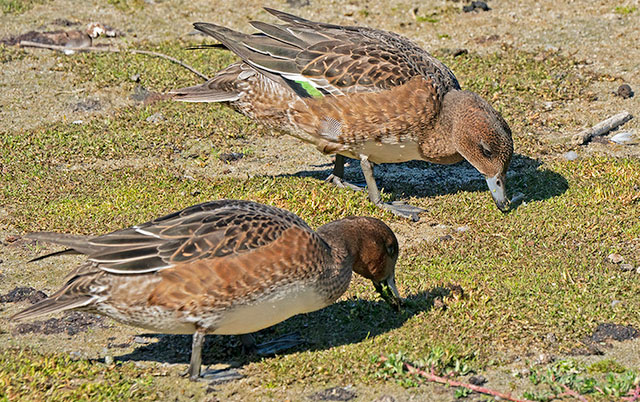
From 13-25 Oct, at first one, and then two, Eurasian Wigeon took up residence at the east end of Laguna Grande, grazing on emerging tips to grass on the sandbar below the east-end bridge. Most experts contacted opined they were hatch-year birds, but opinions diverged as to what sex they were (it might have been one male and female). In any event, they were fun to study at close range (the two are together, left; photo 19 Oct © Bill Hill). These are the first records for Laguna Grande. While a few Eurasian Wigeon winter on Elkhorn Slough annually, it is a very rare bird on the Monterey Peninsula. |
|
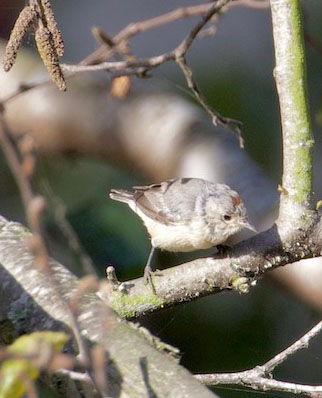 In mid-September, Terence Degan followed up on his August Brewer's Sparrow with a Bay-breasted Warbler on the the MTY side of the Pajaro River on 16 Sep (above left, photo © T. Degan). Terence would find an even better bird in October. In mid-September, Terence Degan followed up on his August Brewer's Sparrow with a Bay-breasted Warbler on the the MTY side of the Pajaro River on 16 Sep (above left, photo © T. Degan). Terence would find an even better bird in October.
Bill Hubick discovered probably the most popular bird the fall: an imm Dickcissel at Laguna Grande on 23 Sep. It would remain a week in a tiny patch of reeds, and essentially every MTY birder who wanted to see it, enjoyed it (above right, photo 24 Sep © D. Roberson). That same day, Bill Hubick also discovered a Lucy's Warbler at Laguna Grande; it would be elusive there through 30 Sep (right, photo 23 Sep © T. Degan). Another Lucy's Warbler was with a flock of Bushtits in Marina on 19 Sep (Kent Van Vuren).
In that same time frame, two rare vireos were found and successfully chased by others: a Plumbeous Vireo at San Carlos cemetery, El Estero, Monterey, found by Carole & Larry Rose. It remained to 30 Sep (below left, photo of it in mid-leap 22 Sep © C. Rose); and a bright Philadelphia Vireo found by Paul Fenwick as he waded in the Carmel River, present 22-23 Sep (below right, photo 22 Sep © P. Fenwick). Equally rare, but not refound by others, was a Blue-headed Vireo near Yankee Pt. on 28 Sep (M. Rieser). |
|
Something went wild this autumn with local Spizella sparrows. Chipping Sparrows breed in MTY's interior; in a normal fall migration a few are scattered to the coast. The vagrants — Clay-colored and Brewer's — occur almost annually, but usually in very small numbers. The weirdness in 2020 started in mid-August, when Terence Degan discovered this Brewer's Sparrow that remained from 13-15 Aug at Frog Pond Preserve, a full month earlier than one would be expected (right, photo 13 Aug © T. Degan). Then six more Brewer's appeared in the more normal span of 13 Sep–20 Oct. We had six Brewer's in fall 2017, so this year's total of seven is a new high
Then migrants Chipping Sparrows, mostly hatch-year birds but some still in juv plumage, were found in amazing numbers. A flock in the Pacific Grove cemetery from 23 Sep–9 Oct ranged from 4–10 a visit (and had a Clay-colored Sparrow). The most impressive flock was at Rancho Cañada in October, with multiple birds most dates, but peaking at 17 Chippies on 9 Oct, when the flock also included two Clay-colored and two Brewer's Sparrows! (Paul Fenwick, Don Roberson, et al.). Paul's photos (below) documented one imm Chipping (just below) and one of the Clay-colored Sparrows (below right). In all, at least 60 Chipping Sparrows were present within the Monterey Peninsula CBC circle area. And in addition to the 6 Brewer's, at least 16 Clay-colored Sparrows were documented, including 3 at Moonglow Dairy on 3 Oct (P. Fenwick, B.L. Sullivan). These are unprecedented numbers. |
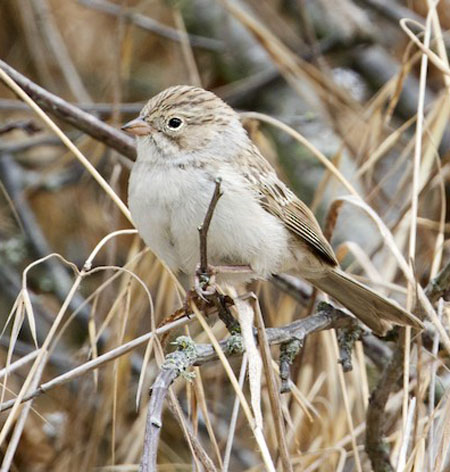 |
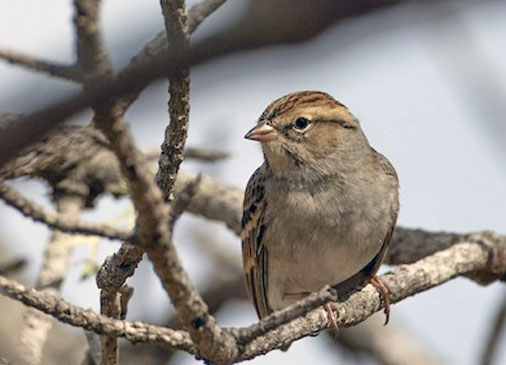 |
 |
|
 |
Scientists are searching the universe for auditory signs of life somewhere out there . . . waaay out there. Brian Sullivan and Paul Fenwick are searching the skies over their Carmel Valley Village homes for audible evidence of night-flying migrants not that far away. It is equipment-heavy, but basically they are recording the sounds of birds (and flying saucers?) overhead by operating NFC stations [nocturnal "flight call stations"]. Brian Sullivan's automatized station recorded this call at 5:20 a.m. on 10 September (sonogram above). You can listen to this vocalization on eBird. This vocalization was recorded several times as it flew over.
So what is it? Brian writes in eBird: "Identification by Michael O'Brien as female 'chur' nocturnal flight call of large rail sp., likely Ridgway's Rail. There appears to be no easily accessible reference material for Ridgway's Rail flight calls, but presumably these are similar to King and Clapper rails. . . . I'm not sure one could rule out a vagrant King Rail, but given the proximity to current and historical Ridgway's Rail range, it seems exceedingly more likely that this is a call from a wandering Ridgway's than a vagrant King."
So it seems we have night-flying rails overhead that could plop down anywhere — maybe even your yard? As you presumably already know, Elkhorn Slough once had a resident population of Ridgway's Rail, back before what was then-called "Clapper Rail" was split into several species. The last known sighting of MTY Ridgway's Rail was in January 1980 (Roberson 2002). This is the first evidence of a potential Ridgway's Rail in MTY in 40 years.
Sullivan's NFS also recorded several Elegant Terns nightly from 8-12 Sep (one recording is at the eBird link for the rail, above). While Elegant Terns sometimes fly over the Monterey Peninsula at night (perhaps most often in foggy weather?), Carmel Valley Village is a fair distance inland. What are they doing here?
|
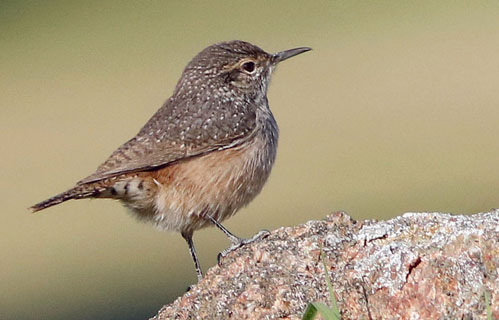
Of significant local interest was a Rock Wren that frequented the El Carmelo Cemetery in Pacific Grove from 2-6 Sep (Nico Schnack). Rock Wren has a wide range within its specialized habitat in the southern half of Monterey County: rocky canyons and, especially, rocky outcrops in barren ravines in the far southeast. The first one ever reported on the Monterey Peninsula was back on the CBC of December 1967. There have only been 7 records in the 53 years since then. This year's Rock Wren favored the one big boulder in the cemetery (left, photo 2 Sep © D. Roberson), and the rest of the time perched on gravestones in the oldest part of the cemetery. |

As we've seen (above), fall 2020 was quite a good season for vagrant passerines. It was also pretty good for two regular-but-rare raptors: we had five each of Broad-winged Hawk and Swainson's Hawk. One juv Swainson's Hawk was found by Brian Sullivan in flight over Casa Verde Way in Monterey at 9:30 a.m. on 7 Sep. Brian got out the word, advising birders at Laguna Grande Park, Seaside, to keep an eye to the sky. Just 12 minutes later, Rita Carratello spotted it over Laguna Grande (right, photo © D. Roberson) and multiple birders there got to see it.
Fall migration for waders, in contrast, was sparse, except for good numbers of Baird's Sandpipers at shallow, non-tidal spots (39 at one locale on 11 Sep was an all-time high count for MTY; B.L. Sulivan). A continued reduction in habitat for non-tidal shorebirds, and restricted access issues, don't help. MTY had just 2-3 Semipalmated Sandpipers in Aug-Sep, and a single Sharp-tailed Sandpiper on 4 Oct (Bill Hubick). Paul Fenwick found probably the best two waders, book-ending the fall migration: a juv Stilt Sandpiper in the lower Salinas Valley on 1 Sep (below left, photo © P. Fenwick), and a Mountain Plover there on 19-21 Oct (below right, photo © D. Roberson). |
|
| |
Literature cited:
- Roberson, D. 2002. Monterey Birds, 2d ed. Monterey Audubon Society, Carmel, CA.
|
|
TOP
GO TO
HOME PAGE
TO MONTEREY
COUNTY
PAGE
TO BIRD
FAMILIES
OF THE WORLD
|

 The most exceptional bird for December appeared in a backyard at the Lobos Ranch development on 21 Dec: an immature Painted Bunting (right; photo © John Hiles). Unfortunately it did not linger, and was never seen again. This is the 16th MTY record, almost all of which have been hatch-year birds in fall, but this Dec vagrant was quite late. Five of the prior records were from residential back yards.
The most exceptional bird for December appeared in a backyard at the Lobos Ranch development on 21 Dec: an immature Painted Bunting (right; photo © John Hiles). Unfortunately it did not linger, and was never seen again. This is the 16th MTY record, almost all of which have been hatch-year birds in fall, but this Dec vagrant was quite late. Five of the prior records were from residential back yards. The best bird found on the Monterey Peninsula CBC on 28 Dec was an Eastern Phoebe along the Carmel River, just upstream from the Highway 1 bridge, discovered by Bill Hill (photo right, © Bill Hill). Also on the count was a Tropical Kingbird, probably returning for a second winter, at Laguna Grande, which appears to have arrived about 30 Oct. At Locke-Paddon Park in Marina a Northern Waterthrush is wintering; it also apparently arrived on 30 Oct. Meanwhile, a young Costa's Hummingbird at a yard in Carmel Valley Village, which first arrived 5 Aug, is wintering (B.L. Sullivan; an extensive series of photos in eBird document its body molt throughout fall and into winter).
The best bird found on the Monterey Peninsula CBC on 28 Dec was an Eastern Phoebe along the Carmel River, just upstream from the Highway 1 bridge, discovered by Bill Hill (photo right, © Bill Hill). Also on the count was a Tropical Kingbird, probably returning for a second winter, at Laguna Grande, which appears to have arrived about 30 Oct. At Locke-Paddon Park in Marina a Northern Waterthrush is wintering; it also apparently arrived on 30 Oct. Meanwhile, a young Costa's Hummingbird at a yard in Carmel Valley Village, which first arrived 5 Aug, is wintering (B.L. Sullivan; an extensive series of photos in eBird document its body molt throughout fall and into winter).

 Mountain Bluebird is a regular winter visitor to barren grasslands in the southeast corner of MTY, in varying numbers year-to-year. The species is otherwise quite rare around the Central Coast, and there are only about 8 records on or near the immediate coast of MTY in the last 50 years.
Mountain Bluebird is a regular winter visitor to barren grasslands in the southeast corner of MTY, in varying numbers year-to-year. The species is otherwise quite rare around the Central Coast, and there are only about 8 records on or near the immediate coast of MTY in the last 50 years.  We understand that many migrant passerines in fall migration undertake flights at night, and if they are misoriented they may find themselves out over the ocean at dawn. It is believed, based on studies on the Farallon Islands, that such migrants "backtrack" to the nearest land to rest and forage before continuing their migration. In theory, then, a migrant passerine could occur almost anywhere along our coastline. Kathleen Keef, a visitor from Reno, encountered two very unexpected fall vagrants in coastal beach scrub in early December. One was this Green-tailed Towhee on the driftwood-littered sand at Big Sur R. mouth, found on 2 Dec and still present a week later (right, photo from 9 Dec © Karen Kreiger). This was the 3rd MTY Green-tailed Towhee for fall migration 2020. The others were at Martin Canyon, off lower Carmel Valley, 4-5 Oct (Michael Rieser) and another upstream of the Big Sur R. mouth on 5 Oct (Aaron Gabbe).
We understand that many migrant passerines in fall migration undertake flights at night, and if they are misoriented they may find themselves out over the ocean at dawn. It is believed, based on studies on the Farallon Islands, that such migrants "backtrack" to the nearest land to rest and forage before continuing their migration. In theory, then, a migrant passerine could occur almost anywhere along our coastline. Kathleen Keef, a visitor from Reno, encountered two very unexpected fall vagrants in coastal beach scrub in early December. One was this Green-tailed Towhee on the driftwood-littered sand at Big Sur R. mouth, found on 2 Dec and still present a week later (right, photo from 9 Dec © Karen Kreiger). This was the 3rd MTY Green-tailed Towhee for fall migration 2020. The others were at Martin Canyon, off lower Carmel Valley, 4-5 Oct (Michael Rieser) and another upstream of the Big Sur R. mouth on 5 Oct (Aaron Gabbe). 
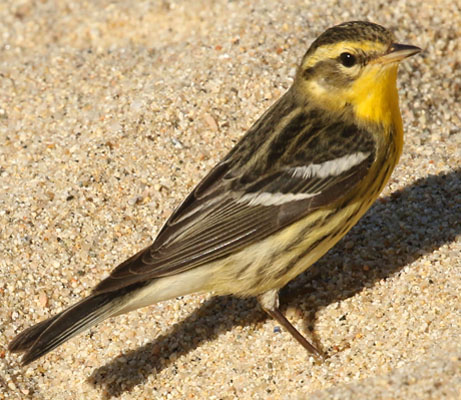
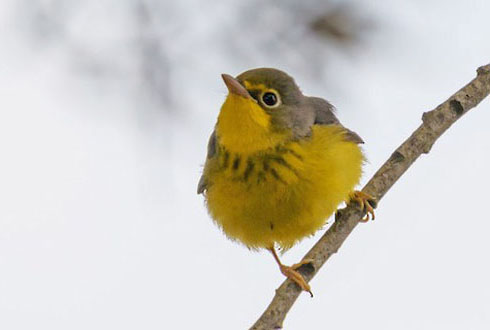
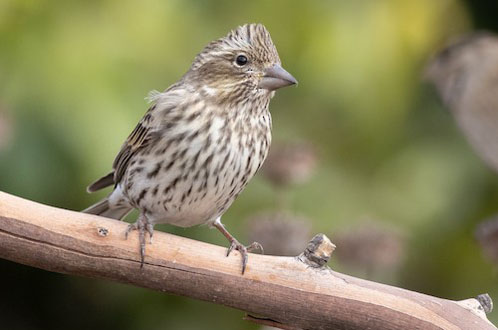
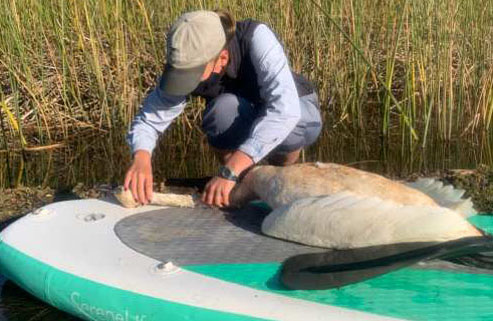
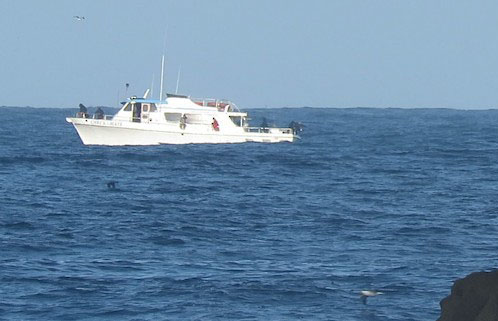
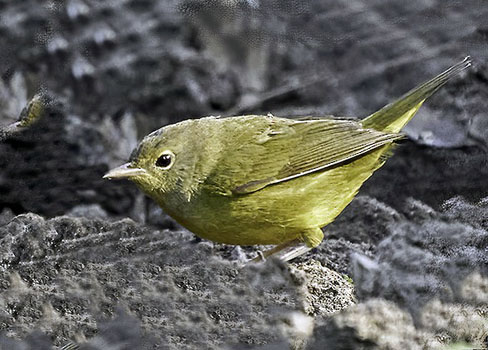
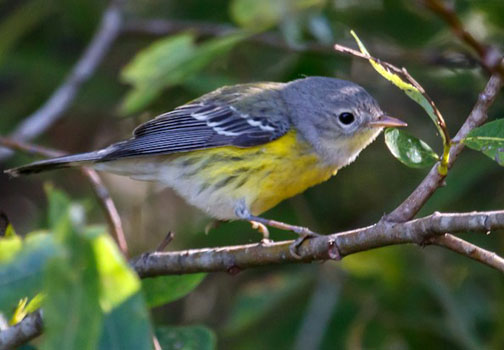
 October also brought the first "chasable" Mourning Warbler for quite some years. Mark Kudrav discovered this hatch-year female frequenting the edge of run-off puddles in Hatton Canyon on 3 Oct; it remained through 5 Oct (above left, photo 5 Oct © Bill Hill). It was mainly quite secretive but it called often, which was a big help. The last "chasable" Mourning was back in 1996. This represents the 15th MTY record. There were just two Magnolia Warbler this fall; this colorful example was near Carmel River mouth on 11 Oct , found by Carole & Larry Rose (above right, photo © Carole Rose).
October also brought the first "chasable" Mourning Warbler for quite some years. Mark Kudrav discovered this hatch-year female frequenting the edge of run-off puddles in Hatton Canyon on 3 Oct; it remained through 5 Oct (above left, photo 5 Oct © Bill Hill). It was mainly quite secretive but it called often, which was a big help. The last "chasable" Mourning was back in 1996. This represents the 15th MTY record. There were just two Magnolia Warbler this fall; this colorful example was near Carmel River mouth on 11 Oct , found by Carole & Larry Rose (above right, photo © Carole Rose).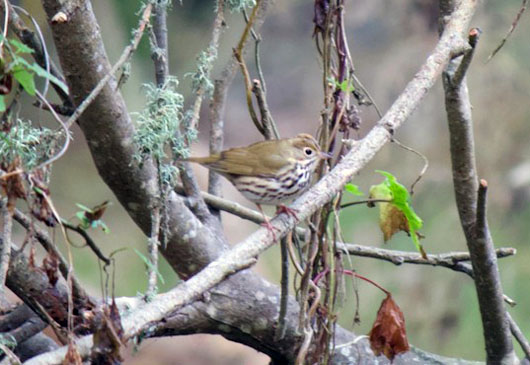




 In mid-September, Terence Degan followed up on his August Brewer's Sparrow with a Bay-breasted Warbler on the the MTY side of the Pajaro River on 16 Sep (above left, photo © T. Degan). Terence would find an even better bird in October.
In mid-September, Terence Degan followed up on his August Brewer's Sparrow with a Bay-breasted Warbler on the the MTY side of the Pajaro River on 16 Sep (above left, photo © T. Degan). Terence would find an even better bird in October. 